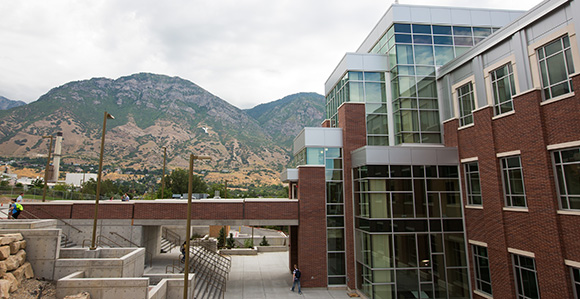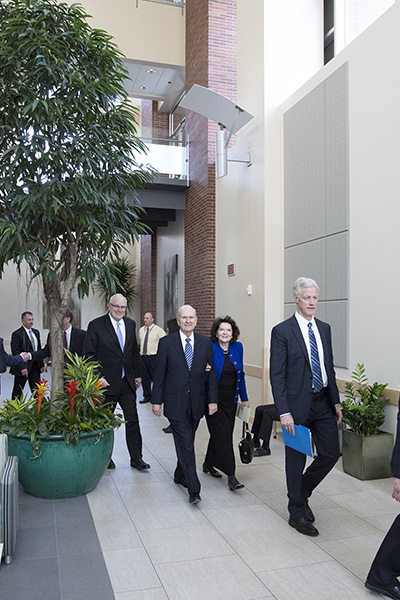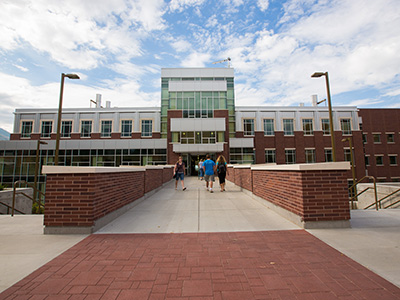Church Leaders Gather at BYU’s Life Sciences Building for Dedication
Contributed By Marianne Holman Prescott, Church News staff writer

The Life Sciences Building on the BYU campus.
Article Highlights
- The Life Sciences Building is more than just a building; it will serve ecclesiastical purposes, as well as allow students to learn about God’s creations in a scientific setting.
- Elder Russell M. Nelson dedicated the building, with Elder Paul V. Johnson of the Seventy in attendance.
“All truth is part of the gospel of Jesus Christ. Whether truth comes from a scientific laboratory or by revelation from the Lord, it is compatible.” —Elder Russell M. Nelson of the Quorum of the Twelve
Related Links
PROVO, UTAH
“There is no conflict between science and religion. Conflict only arises from an incomplete knowledge of either science or religion, or both,” Elder Russell M. Nelson of the Quorum of the Twelve Apostles said during the dedication of the new Life Sciences Building at Brigham Young University on April 9.
“This university is committed to search for truth and teach the truth,” said Elder Nelson. “All truth is part of the gospel of Jesus Christ. Whether truth comes from a scientific laboratory or by revelation from the Lord, it is compatible.”
Although the building has already been holding classes for a few months, an official dedication brought community members and Church leaders to the “gateway” of the south end of the college’s campus. Elder Nelson and BYU President Kevin J Worthen spoke during a dedicatory service, with the Apostle offering a dedicatory prayer. Elder Paul V. Johnson, Church Commissioner of Education, attended the event.
“In this facility, the focus will be centered on learning from and about God’s living creations,” Elder Nelson said.
The 265,000-square-foot, five-level building opened its doors for the fall 2014 semester—a little more than two and a half years after it was announced in November of 2011. Built to look like water running down the hill through red rocks, the new building will be the home of the College of Life Sciences and five of its seven departments—biology, health science, microbiology and molecular biology, physiology and developmental biology, and plant and wildlife sciences. It will provide facilities for the faculty, staff, administrative personnel, and more than 5,000 student majors.
In addition to its purposes as an academic facility, the building will serve ecclesiastical purposes, housing one stake and 15 wards, with three of those wards holding all of their Sunday meetings in the building.

Elder Russell M. Nelson and Sister Wendy Nelson follow BYU President Kevin J Worthen through the halls of the newly dedicated Life Sciences Building. Elder Paul V. Johnson, Church Commissioner of Education, follows the Nelsons. Photo by Mark A. Philbrick.

: Elder Russell M. Nelson of the Quorum of the Twelve Apostles speaks during the Life Sciences Building dedication on April 9. Photo by Mark A. Philbrick.

BYU President Kevin J Worthen speaks during the Life Sciences Building dedication on April 9. Photo by Mark A. Philbrick.

The Life Sciences Building on the BYU campus. Photo by Jaren Wilkey, BYU.
More than the actual physical building—although it is impressive—the new space is a place for students to learn about the creations of God in a scientific setting.
“Research and education are religious responsibilities for members of The Church of Jesus Christ of Latter-day Saints,” said Elder Nelson. “For we know that ‘the glory of God is intelligence.’ And our perspective is enlarged by knowing that ‘whatever principle of intelligence we attain unto in this life, it will rise with us in the resurrection.’”
There will always be more to learn, the Apostle said, especially when studying topics that relate to the Creation, physiology, and laws of life.
“Why?” he asked. “Because life comes from God. There will always be a gap between what He knows and what we now know.”
The new facility allows students and teachers to focus learning from—and about—God’s living creations.
“Now I will confess a personal prejudice,” he said. “I think that a person can learn more by studying God’s creations than by studying the works of people, even by the most erudite and educated scholars.”
Elder Nelson was a world-renowned cardiothoracic surgeon at the time he was called to the Quorum of the Twelve Apostles in 1984. Of his early days of research into the workings of the human heart, he spoke of how crucial it was to combine the knowledge he had with personal revelation—providing the undergirding foundation to his work.
“The great privilege of studying God’s creations builds in its students a reverence for life and a testimony that we are literally created by Deity,” he said. “That reverence for our Creator represents true religion. The meaning of the word religion is literally ‘to ligate,’ or ‘to tie us once again,’ back to God.
“For students, there is nowhere better to confront the questions shared between science and religion than in the College of Life Sciences at Brigham Young University,” Elder Nelson said. “What a blessing this building will be.”
President Worthen shared some thoughts about the history of the College of Life Sciences at BYU. What started with a small and slow start in 1954 has turned into a thriving college that includes seven departments, including an entire center dedicated to the study of DNA sequencing.
“And most of all, we have this wonderful facility designated with laboratory space and meeting areas that allow both faculty and students to engage in cutting-edge research,” President Worthen said. “This building is a tangible and very large reminder that we really have come a long way in life sciences in the last 60 years.
“But the building is only a structure, with little to contribute by itself to the advancement of the purposes of BYU. The type of building that houses the College of Life Sciences is not nearly as important as the type of people who will teach and study here.”
Drawing again from the history of the college, President Worthen told of John A. Widtsoe—the man whom the college’s last building was named after and who was BYU’s first PhD-prepared professor. Although he spent only two years at BYU, he made a large impact on how the college is today, in addition to his service as an Apostle and as Commissioner of Education for the Church.
“During his life, John A. Widtsoe did as much as any contemporary to establish the link between science and the gospel,” he said. “With unparalleled spiritual and intellectual prowess and energy, he sought to erase the artificial distinction between scientific and religious truth. For him, science and religion were inextricably united.”
Just as the educators who came before, that same purpose remains today—to help students learn about scientific and religious truth in the same context.
